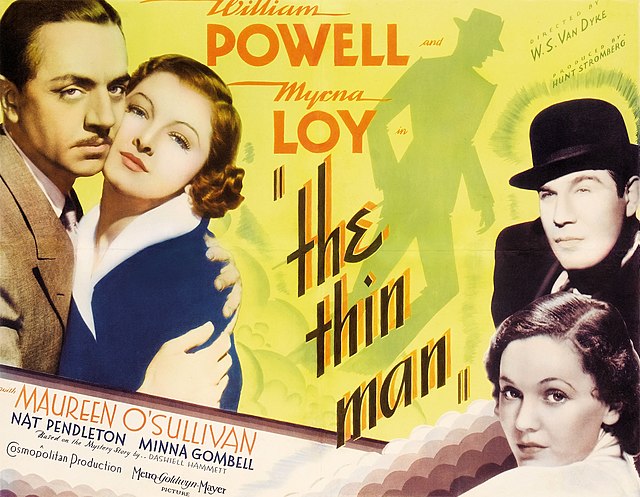Rather Than the Mysteries, the Tart and Playful Tête-à-Têtes Are the Most Notable Reason To Watch ‘The Thin Man’ Series
Written by a married couple for a fictional married couple, the dialogue in the films is as pithy as anything by Hemingway and as skillfully crafted as the best of P.G. Wodehouse’s bon-mots.

Not long ago, I listened to a podcast featuring a pair of millennial movie fans chatting as they combed through films included in the Criterion Collection. Edward F. Cline’s “The Bank Dick” (1940) came upon their radar and, suffice it to say, they were aghast. Who, they asked with the straightest of faces, was the misogynistic substance abuser at the center of the picture and why didn’t he take pride in his children?
Admittedly, W.C. Fields is best appreciated as one gets older. Still, talk about missing the comedic forest for the PC trees. It’s enough to make a reasonable man take to drink.
Speaking of taking to drink, the husband-and-wife detective team created by crime novelist Dashiel Hammett, Nick and Nora Charles, did so, and drink they did. One is loath to recommend promiscuous imbibing as a lifestyle choice, but fictional characters have a leeway that the rest of us are without.
During the run of W.S. Van Dyke’s “The Thin Man” (1934), Nick Charles can be seen hoisting a glass 21 times. To which one is tempted to reply: Is that all? Insouciance is easily mistaken for intoxication, but Nick Charles does hold his liquor with engaging aplomb.
Will there be a content warning, then, for the Warner Archive Collection’s Blu-ray set, “The Complete Thin Man Collection”? The series spanned 13 years, ending with “Song of the Thin Man” (1947), the only movie of the franchise that didn’t turn a profit. Perhaps post-war audiences wanted to shirk entertainments redolent of the Depression era. Popular tastes do move on and movie stars get older: William Powell was 55 at the time of filming; Myrna Loy, 42. Then again, we should all be so dapper, beautiful, and witty upon entering our senescence.

Did you know that Nick Charles was Greek? Readers of the novel are wise to our hero’s heritage, but Hammett gave us one and only one book devoted to the retired detective and his socialite wife. Spurred by the success of “The Thin Man” film, Hollywood proved more generous and the public was grateful for it. Did the studio execs who initially fretted about Loy’s ethnicity — before she was Nora Charles, Loy had been the daughter of Fu Manchu — ever admit to their short-sightedness? Likely not.
Much like the misunderstanding surrounding “Frankenstein” (1931), “The Thin Man” is a brand name that shouldn’t be mistaken for its signal character. The moniker belongs to an inventor who set the series into motion by disappearing under mysterious circumstances. When plied upon by the inventor’s daughter to find the “thin man,” Nick agrees to take up the case, albeit grudgingly. He would much prefer enjoying retirement in his luxurious Manhattan apartment with his equally luxurious wife. Still, Nora eggs on Nick to get back into the life. Their schnauzer, the immortal Asta, is inclined to agree.
The mysteries at the heart of the films are unexceptional bordering on humdrum. Although Hammett provided basic story outlines for the original film as well as the two immediate sequels, “After the Thin Man” (1936) and “Another Thin Man” (1939), the series didn’t provide much in the way of nail-biting tension or edge-of-the-seat intrigue. As scripted by Frances Goodrich and Albert Hackett, the primary focus was the tart and playful tête-à-têtes between Nick and Nora.
That Goodrich and Hackett were a married couple undoubtedly gave them a leg up in terms of creating the teasing naturalism at the heart of the films. That there was a crime or two occurring in the general vicinity of the Charles family is all but ancillary. As Nora would have it in a later movie, “Bing! Bing! There’s another murder.”
The dialogue in the films is as pithy as anything by Hemingway and as skillfully crafted as the best of P.G. Wodehouse’s bon-mots. Goodrich and Hackett picked up Hammett’s knack for elastic circumlocutions and ran with it. Even in “Song of the Thin Man,” by general consensus the weakest of the films, there’s talk to delight in. Here Nora lauds Nick’s gangland cronies: “I love them. They’re perfect gentlemen — right down to their fingerprints.”
The chemistry between Powell and Loy is among the joys of American cinema, though not enough credit is given to Van Dyke in terms of fomenting it. A journeyman director, Van Dyke approached an assignment, sized it up, and then got in and got out: The sobriquet “One Take Woody” was well earned.
The studio bosses loved him for coming in under budget; the actors loved him for encouraging spontaneity. Loy credited Van Dyke’s loose-limbed ways for fostering the charms of the “Thin Man” series. Four of the six pictures in the current set have Van Dyke’s name on them. That’s no small contribution to cinematic culture.

